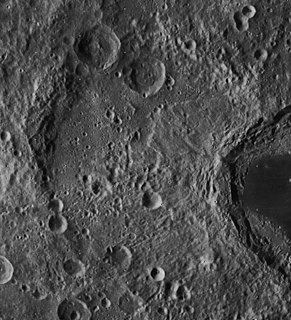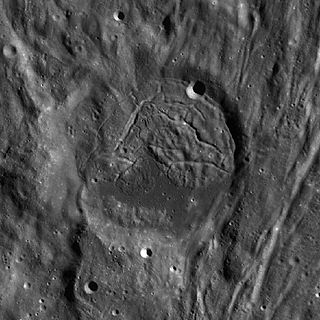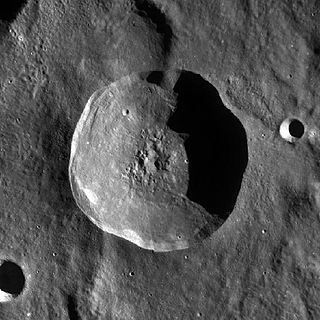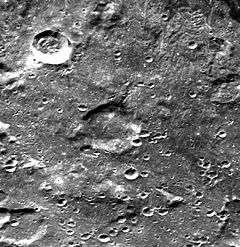
Andersson is a lunar impact crater that lies in the southern hemisphere on the far side of the Moon. It is located just beyond the southwestern limb of the visible Moon in a location that can be viewed from the side during a favorable libration. The nearest crater of note is Guthnick to the north-northeast.

Alekhin is a lunar impact crater that is located on the southern hemisphere on the far side of the Moon. It lies to the north of the crater Zeeman, and south-southeast of Fizeau. To the west lies Crommelin, and east-southeast is Doerfel.

Arrhenius is a lunar impact crater that is located just on the far side of the Moon, near the southwest limb. In this location the vicinity of the crater can be viewed during favorable librations, although it is viewed from on edge. To the south-southeast is the worn crater Blanchard, and De Roy lies further to the west.

Artem'ev is a lunar impact crater that is located on the far side of the Moon. The rim of this crater has been modified by subsequent impacts in the vicinity, with an inward bulge along the southwest edge and a worn impact lying across the north rim. The satellite crater Artem'ev G is partly overlain by the southeast rim of Artem'ev. The crater interior is relatively flat, and marked only by tiny craterlets.

Avicenna is a lunar impact crater that lies on the far side of the Moon, just beyond the western limb on the northern rim of the Lorentz basin. It is named after the Persian physician Avicenna. It lies to the north-northwest of the larger crater Nernst, and to the southeast of Bragg.

Barringer is a lunar impact crater that is located on the southern hemisphere on the Far side of the Moon, named after geologist Daniel Barringer. It is attached to the north-northeastern rim of the walled basin named Apollo, and lies to the southeast of Plummer. South of Barringer, on the floor of the Apollo basin, is the crater Scobee.

Blanchard is a lunar impact crater that lies on the far side of the Moon, just behind the southwestern limb. It lies to the south-southwest of the crater Arrhenius, and northwest of Pilâtre. Further to the south is the rugged terrain to the north of the walled plain Hausen.

De Roy is a lunar impact crater that is located on the far side of the Moon, just behind the southwestern limb. This portion of the lunar surface is brought into view during favorable librations, allowing observation of this formation. However the crater is viewed from the side when watched from the Earth, and little detail can be seen. De Roy lies to the west of the crater Arrhenius, and east of the larger Boltzmann.

Darwin is a lunar impact crater of the type categorised as a walled plain. It lies in the southeastern part of the Moon, and is sufficiently close to the limb to appear significantly foreshortened when viewed from the Earth. Attached to its southern rim is Lamarck. To the northeast is the dark-floored crater Crüger.

Fermi is a large lunar impact crater of the category named a walled plain. It was named after Italian-American physicist and Nobel laureate Enrico Fermi. It lies on the far side of the Moon and can not be viewed from the Earth. Thus this feature must be viewed from an orbiting spacecraft.

Catalán is a small lunar impact crater that lies almost along the southwest limb of the Moon. At this position the crater is ill-suited for observation from the Earth as it is viewed almost from the side, and visibility is subject to libration effects. It lies to the west of the somewhat larger crater Baade, and south-southeast of Graff. This region is located in the outer southeastern part of the skirt of ejecta that surrounds the Mare Orientale impact basin, and the nearby surface is rugged and streaky. This crater is named after the Spanish scientist Miguel Antonio Catalán Sañudo (1894–1957) for his contributions to spectroscopy, an important exploratory tool in astronomy.

Cannizzaro is a lunar impact crater that is located on the Moon's far side as seen from the Earth, just beyond the northwestern limb. It lies in a region of the surface that is sometimes brought into view due to the effects of libration, but not much detail can be seen since this feature is viewed from the side. The crater lies across the southwestern rim of the much larger-walled plain Poczobutt.

Couder is a small lunar impact crater that is located just behind the western limb of the Moon, in a region of the surface that is brought into view during favorable librations. It lies on the inner foothills of the Montes Cordillera, a ring-shaped mountain range that surrounds the Mare Orientale impact basin.

Dyson is a lunar impact crater, 63 kilometers in diameter, that lies on the far side of the Moon, past the northwest limb. It is located in the northern part of the surface, to the northwest of the crater Coulomb, and east of van't Hoff.

Chappe is a lunar impact crater that lies along the southwestern limb of the Moon. It is nearly attached to the northern limb of the walled plain Hausen, and an equal distance from the crater Pilâtre. To the north-northwest is Blanchard.

Fényi is a small lunar crater on the far side of the Moon. It lies near the southern edge of the huge, braided skirt of ejecta that surrounds the Orientale impact Basin to the north. Less than two crater diameters to the southwest is the much larger crater Mendel.

Fridman is the remains of a lunar impact crater on the far side of the Moon. It lies due south of the huge walled plain Hertzsprung, and is attached to the northeastern rim of the crater Ioffe.

Guthnick is a lunar impact crater that lies on the far side of the Moon's surface from the Earth. However, it is located in the part of the far side that is sometimes brought into sight of the Earth due to libration, although it can only be seen at a low angle and during favorable lighting conditions. Guthnick is situated in the southern portion of the huge skirt of ejecta that surrounds the Mare Orientale impact basin. Less than a crater diameter to the northwest is the slightly larger crater Rydberg. To the south-southwest is the small Andersson.

Stefan is a lunar impact crater on the far side of the Moon, just beyond the northwestern limb. Attached to the western rim is the slightly smaller crater Wegener, and close to the eastern rim is Rynin.

Sundman is a lunar impact crater that lies just past the western limb of the Moon. Although it lies on the far side from the Earth, this part of the surface is brought into view during periods of favorable libration and illumination. Sundman lies to the southwest of the walled plain Einstein, and to the west of the Vallis Bohr cleft. It was named after Finnish mathematician and astronomer Karl F. Sundman.





















